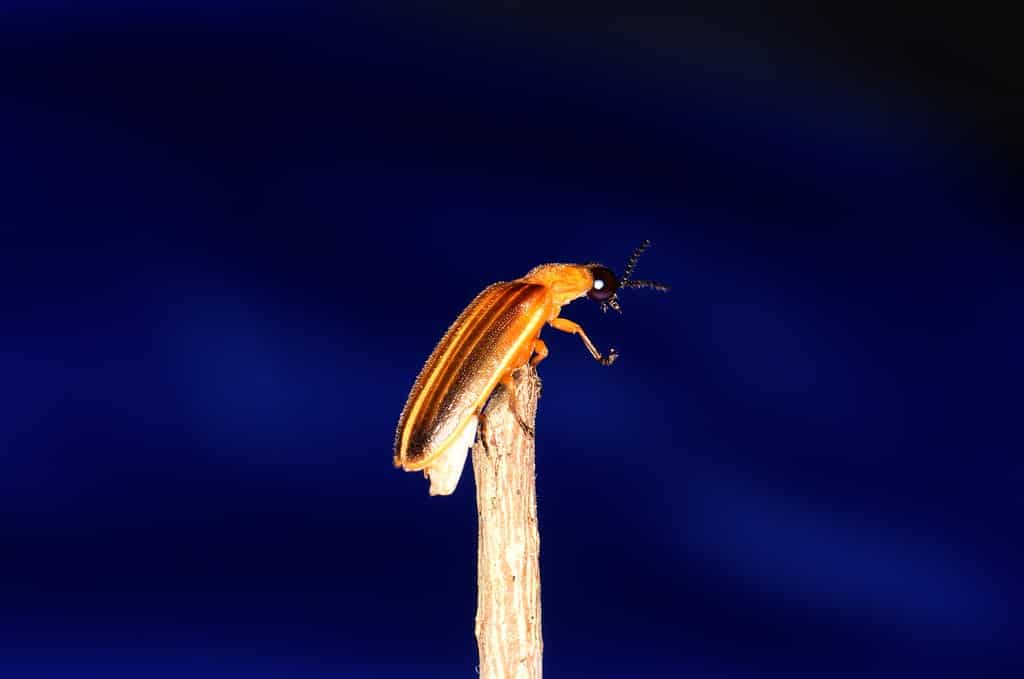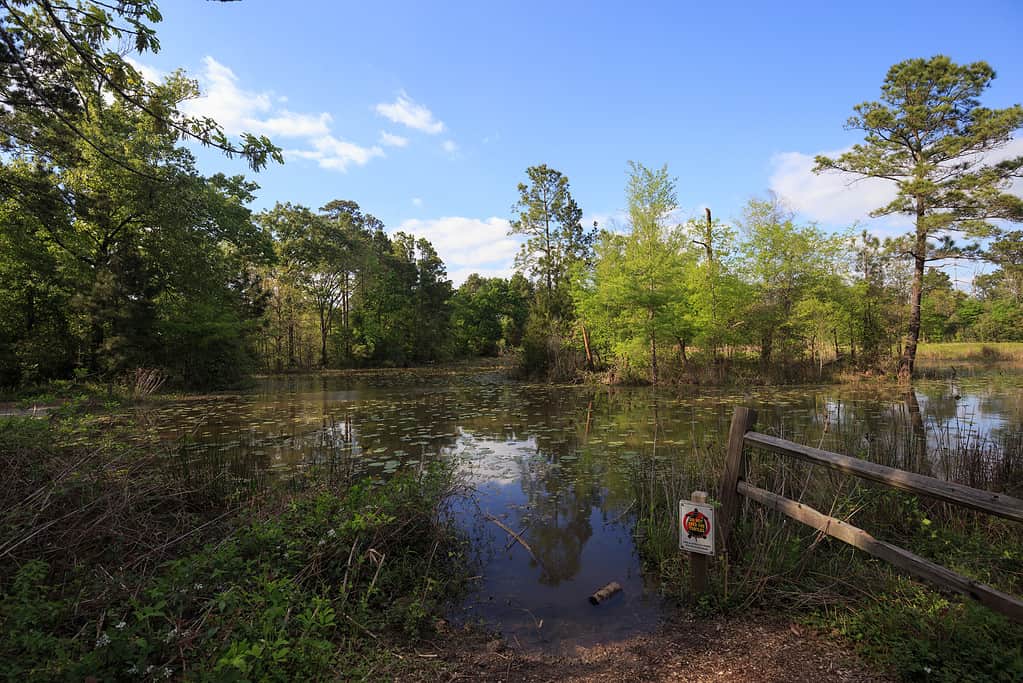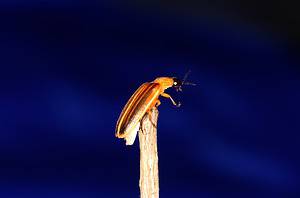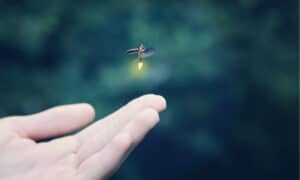Texas is home to several species of fireflies. While these may all look very similar to the untrained eye, each firefly can be found in a different environment and has its own light-up pattern (which helps mates of the same species find each other).
Because there are so many fireflies in Texas, you can find them just about everywhere, including wetlands, fields, and gardens. If you’re outside in the spring or summer in Texas, you’ll probably see some fireflies.
If you’re interested in learning what fireflies you can expect to see and where to find them, keep reading.

Each type of firefly can be found in a different environment and has its own light-up pattern.
©Fer Gregory/Shutterstock.com
Types of Fireflies in Texas
1. Photinus concisus
The Photinus concisus is one of the most common firefly species in Texas. It’s found mostly in central Texas, especially around Kerrville. It’s closely related to the Photinus phyralis, which is the most common firefly species in North America.
This firefly grows to 9.3 – 12.5 mm long. It has a black head, a reddish section behind the head, and dark brown wing covers edged in yellow. The main difference between this species and the Photinus phyralis is that it has a completely black or brown abdomen, while the Photinus phyralis has a yellow margin.
This species flashes once for about 0.4 seconds every two seconds. They fly at 76 degrees Fahrenheit – usually around late April and early June. In response to the male, the female will flash for about 0.6 seconds, about half a second after the male’s flash. However, this flashing interval can change depending on the temperature and group size.
The Photinus concisus is found in many different habitats. It prefers moist, shady areas with plenty of vegetation.
2. Photinus dimissis
The Photinus dimissis is another species of firefly found in Texas and other parts of North America. It’s a very small firefly that only grows from 5 to 7 mm in size. It has a triangular or roundish spot on its head and dark wing coverings with a yellow border. Its flashing pattern is often described as “twinkling.”
This species will flash for about 0.08 seconds at a time every second. They fly around 74 degrees Fahrenheit. However, they’re pretty fast and stay low to the ground or very high in the canopy. The female will respond with a similar flash about half a second after the male.
This firefly prefers similar environments to others. It likes moist, shady areas like woodlands and fields. They’re found in the same areas as the Photinus pyralis, but they are less common.
3. Photinus pyralis
The Photinus pyralis is one of the most common fireflies in all of North America. It’s also called the common eastern firefly. You can identify it thanks to the triangular spot on top of its head and the yellow margin around its abdominal area. Plus, it also has a characteristic J-shaped flight pattern.
This firefly flashes one flash that’s about 0.3 seconds long every six seconds. The female will respond with another single flash about 0.6 seconds long, 2.2 seconds after the male’s flash. The flash is yellow-green, which can also make this firefly easier to identify.
These fireflies prefer meadows, woodlands, fields, and similar habitats. They’re commonly found in disturbed habitats like yards and parks. They’re mostly found in open areas, though you can also see them near woods and streams.

, known as the common eastern firefly, has a characteristic J-shaped flight pattern.
©iStock.com/ErikAgar
4. Photinus stellaris
The Photinus stellaris is another species of firefly found in Texas. This species has a unique flash pattern that resembles a starburst, hence its common name, “starry firefly.” It has a dark brown body with a yellow margin.
This species flashes a single time of about 0.3 seconds every three seconds or so. The female responds with a flash of her own that’s twice as long as the male’s and about 1.5 seconds afterward. However, flashing patterns can vary based on temperature and light conditions.
They’re found in meadows, woodlands, and fields – just like most species of firefly.
These fireflies typically emerge 15 minutes after sunset and fly for about 15 minutes. They prefer open areas.
5. Photinus texanus
This species of firefly is only found in Texas and Coahuila, Mexico. It’s also known as the Texas firefly for this reason. It has a dark body and a yellow margin, like many other species on this list. You can tell it apart mainly due to its flash pattern.
The Photinus texanus flashes a single time for about 0.5 seconds every half second. The female responds with a flash that’s barely longer than the male’s flash. Sometimes, these fireflies form large groups that flash synchronously or nearly synchronously.
They prefer to live in moist areas with lots of vegetation, including woodlands, fields, and streams. This species flies very fast, which is one way you can identify them.
6. Photuris frontalis
This species is found in the southern US and Texas. It has a humpback body and an hourglass-shaped spot on its head, which makes it easier to identify. Plus, it also has a pretty unique flash pattern.
The Photuris frontalis flashes once for about 0.08 seconds every second or so. The flash is bimodal, which means that it has two peaks of brightness. The female responds to the male with a similar flash after half a second.
Like some other species, the Photuris frontalis sometimes forms groups that flash nearly synchronously. They’re found in the same places you’ll find other fireflies – moist, shady forests and streams.
7. Photuris pennsylvanicus
As the name suggests, this species of firefly is most common in Pennsylvania. However, they can also be found in Texas.
They have a black body with two red spots on their thorax, making them pretty easy to identify. They also have an orange spot on the top of their head.
The Photuris pennsylvanicus flashes one time for 0.3 to 0.8 seconds. The length between flashes can be between 1.5 to 6 seconds. Their flashes are much less uniform than other species. However, it depends largely on the temperature. They do fly more often than other species, which may be why their flash intervals vary so much.
This species will also mimic the flash of other firefly species to lure and prey on other fireflies.

is commonly known as the Pennsylvania firefly though it can be found in Texas.
©glebantiy/Shutterstock.com
8. Pyractomena angulata
The Pyractomena angulata is found throughout much of North America, including Texas. They’re completely black with yellow markings on their head shield and wing covers. Plus, they also have an amber-colored flash, which makes them easier to identify.
This species flashes for about 1.5 seconds, which is quite long. Then, they flash for only 0.5 seconds. This sequence of long-short occurs every four seconds. Their light can be seen from a fairly far distance, as it is more orange than yellow. The female flashes back at the male after about one second.
They largely emerge in the early spring, around March and May. They fly for up to an hour after sunset, which is longer than most species.

The
Pyractomena angulatafirefly has an amber-colored flash, which makes them easier to identify.
©Judy Gallagher / Flickr – License
9. Pyractomena borealis
The Pyractomena borealis is found throughout North America, as well. They are very similar to other species in the genus Pyractomena. They have a black body with yellow markings on their head shield and wing covers. Their flash is also amber-colored and flashes in a specific pattern.
They start with a long flash of about 1.5 seconds, followed by a short flash of 0.5 seconds. This sequence occurs every four seconds or so. The female responds to the male after about one second.
They’re found in meadows, woodlands, fields, and similar environments. Like most fireflies, they prefer moist, shady areas. You’ll usually see them in early spring, from March to May.

The
Pyractomena borealisfirefly has a black body with yellow markings on its head shield and wing covers, and an amber-colored flash.
©Paul Reeves Photography/Shutterstock.com
Where to Find Fireflies
Fireflies can be found throughout Texas wherever the conditions are right. However, some areas do make for better viewing than others.
Some fireflies only like undisturbed habitats, such as meadows and woodlands. Others may be found in yards, parks, fields, and roadsides. Generally, all species come out within 15 to 30 minutes after sunset, but most only fly for a few minutes.
Below, we’ll look at some specific places you may find fireflies in Texas.
1. Brazos Bend State Park
The Brazos Bend State Park is full of nature. It features acres of woodland and wetlands, making it a great place to see fireflies – as they like both moist and wooded areas. You can often see fireflies hovering around the water.
This park features 37 miles of trail for you to explore. You can take a nice stroll or hike while looking for fireflies. Plus, you may also see deer, alligators, and turtles in the park.
You can also enjoy the park’s George Observatory, which allows you to see the stars. The park often hosts educational programs and events – some of which may involve fireflies.

Brazos Bend State Park features acres of woodland and wetlands, making it a great place to see fireflies in Texas.
©iStock.com/Richard McMillin
2. Lady Bird Johnson Wildflower Center
This botanical garden is located in Austin, Texas, and includes a huge range of different native plants. The center has nearly 700 species in all, including wildflowers, hummingbirds, and butterflies. It regularly hosts firefly viewing events, too.
The center offers other events besides just fireflies, though. You can regularly see art, architecture, music, and theater performances. The center is open to the public year-round.
If you want to see fireflies, the Ladybird Johnson Wildflower Center is a great option.
3. The Houston Arboretum and Nature Center
The Houston Arboretum and Nature Center is one of the larger centers on this list, covering 155 acres of gardens, woodlands, and wetlands. It’s open daily with free admission, so you can look for fireflies whenever you please.
The center also offers several educational programs, including night hikes. Therefore, they offer several opportunities to see fireflies of all kinds.
Like many nature centers, this one also offers several other events for you to take advantage of, including nature classes, bird surveys, and art events.

The Houston Arboretum Nature Center in Texas features 155 acres of gardens, woodlands, and wetlands to explore.
©iStock.com/DuyDo
4. San Antonio Botanical Garden
As the name suggests, the San Antonio Botanical Garden is located in San Antonio, Texas. It showcases the diverse flora and fauna of the region, making it a great place to see fireflies. It contains 38 acres in total, so it isn’t the biggest attraction on this list.
The garden has the perfect environment for fireflies, so you can often see them in the spring right after sunset.
The center offers many educational activities throughout the year. For instance, you can go on guided walks, workshops, and camps. However, hours vary throughout the year, so be sure to double-check before you head out.
5. Tyler State Park
The Tyler State Park is an interesting place to see fireflies. It sits on 64 acres with extremely tall trees and a spring-fed lake. The park also includes some historic structures that are worth taking a look at.
This park offers some of the best firefly viewing in Texas, especially near the lake. The ground is wooded and moist, which is the perfect habitat for most firefly species.
While you’re there, you can also enjoy some of the other activities at the park, which include swimming, hiking, and boating. There is a nature center and bird blind at the park, as well.
Like most locations on this list, Tyler State Park hosts guided walks, crafts, and stargazing.
6. McKinney Falls State Park
McKinney Falls State Park is another park located in Austin, Texas. It’s on 64 acres and features a spring-fed lake, limestone formations, and historic structures. It’s open daily, though the hours may vary depending on the season.
The park offers fireflies plenty of prime locations, so you can often see tons of flashing in the spring. Like most parks, you can also enjoy swimming, fishing, and similar activities. The park has a visitor center and a nature center, as well.
The photo featured at the top of this post is © khlungcenter/Shutterstock.com
Thank you for reading! Have some feedback for us? Contact the AZ Animals editorial team.






